The monuments list is taken from the Ghana Museums and Monuments Board, according to their description "legal custodian of Ghana's material cultural heritage (movable and immovable heritage)" [1] GMMB classifies the monuments:
The ID used on this page in reference to the Regions of Ghana are based on the ISO Regional ID standards.
| ID | Description | Region | Original function | Built | Location | Address | Comment | Coordinates | Image |
|---|---|---|---|---|---|---|---|---|---|
| GH-AA-001 | National Museum | Greater Accra | Museum | 1957 | Barnes Road, Accra | 5°33′24″N0°12′28″W / 5.556667°N 0.207778°W |  | ||
| GH-AA-002 | Museum of Science & Technology | Greater Accra | Museum | 1963 | Barnes Road, Accra. | Ghana Museum of Science and Technology |  | ||
| GH-AA-003 | Ussher Fort | Greater Accra | Fort | 1649 | Ussher Town, Accra |  | |||
| GH-AA-004 | James Fort | Greater Accra | Fort | 1673 | John Evans Atta Mills High Street, Accra | James Fort Ghana |  | ||
| GH-AA-05 | Christiansborg Castle a.k.a. Osu Castle | Greater Accra | Fort | 1659 | Osu, Accra |  | |||
| GH-AA-06 | Fort Augustaborg | Greater Accra | Fort | 1787 | Teshie |  | |||
| GH-AA-07 | Museum of Archaeology | Greater Accra | Museum | University of Ghana, Department of Archeology, Accra |  | ||||
| GH-EP-08 | Fort Vernon | Greater Accra | Fort | 1742 | Prampram | 5°43′29″N0°07′00″E / 5.7247051°N 0.1167463°E |  | ||
| GH-EP-09 | Holy Trinity Church Accra | Greater Accra | Church | 1894 | Accra High street |  | |||
| GH-EP-10 | Grave ruins of Seagent Adjetey | Accra | Grave | La | Located at the La cluster of school field |  |
| ID | Description | Region | Original function | Built | Location | Address | Comment | Coordinates | Image |
|---|---|---|---|---|---|---|---|---|---|
| GH-TV-001 | Fort Prinzenstein | Volta | Fort | 1734 | Keta | 5°54′39″N0°59′31″E / 5.910833°N 0.991944°E | 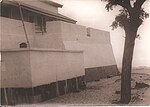 | ||
| GH-TV-002 | Volta Regional Museum | Volta | Museum | 1973 | Ho |  |
| ID | Description | Region | Original function | Built | Location | Address | Comment | Coordinates | Image |
|---|---|---|---|---|---|---|---|---|---|
| GH-AH-001 | Fort Kumasi | Ashanti | Fort | 1820 | Kumasi |  | |||
| GH-AH-002 | Kumasi Military Museum | Ashanti | Museum | Kumasi | 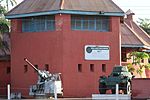 | ||||
| GH-AH-003 | Yaw Tano Shrine a.k.a. Tano Yaw Shrine | Ashanti | Shrine | Ejisu-Besease | at Besease, about 20.8 km on the Kumasi-Accra road. | 5°33′26″N1°11′45″W / 5.5572433°N 1.1959147°W |  | ||
| GH-AH-004 | Akwasi Sima Shrine a.k.a. Kwasi Kuma Shrine | Ashanti | Shrine | Adarkwa Jachie | about 16 km on the Kumasi-Ejisu road. |  | |||
| GH-AH-005 | Tano Abenamu Subunu Shrine | Ashanti | Shrine | Abirem | Abirem is about 12.8 km from Kumasi on the Antoa Road, Coord of Antoa Road | 6°42′30″N1°36′20″W / 6.7082007°N 1.605463°W | 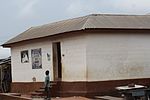 | ||
| GH-AH-006 | Tano Kwadwo Shrine | Ashanti | Shrine | Saaman | Saaman is about 12.6 km north-east of Kumasi, on the former Odumakoma Tempong road that led toNorthern Ghana. |  | |||
| GH-AH-007 | Atuo Kosua Shrine | Ashanti | Shrine | Adwinase | off the Ejisu-Onwi road. | 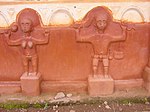 | |||
| GH-AH-008 | Kentinkrono Shrine | Ashanti | Shrine | Kentinkrono | At Kentinkrono, about 20.8km on the Kumasi-Ejisu road. |  | |||
| GH-AH-009 | Tano Odomankoma Shrine | Ashanti | Shrine | Bogwiase | foot of the rocky Mampong scarp, about 10 km from Effiduase, in theSekyere West District. |  | |||
| GH-AH-010 | Asawase Shrine a.k.a. Tano Banie Shrine | Ashanti | Shrine | Asawase near Ejisu | to the south of Ejisu, about 10 km on the second-class road linking Ejisu and Apromase. |  | |||
| GH-AH-011 | Asenemaso Shrine | Ashanti | Shrine | Asenemaso | Kumasi-Sunyani road, at a distance of about 15 km from Kejetia. |  |
| ID | Description | Region | Original function | Built | Location | Address | Comment | Coordinates | Image |
|---|---|---|---|---|---|---|---|---|---|
| GH-NP-001 | Larabanga Mosque | Northern Region | Mosque | 14th Century | Laribanga |  | |||
| GH-NP-002 | Bole Mosque | Northern Region | Mosque | Bole Mosque is in West Gonja District, in the Northern Region. |  | ||||
| GH-NP-003 | Babatu's grave | Northern Region | Old Grave | Yendi | Babatu was a notorious slave raider from Niger. There are remains of his grave and some equipment he and his army used in capturing slaves on Grunsi land. |  | |||
| GH-NP-004 | The German cemetery | Northern Region | Cemetery | Yendi | German cemetery popularly called "German grave” contains graves of German and Dutch soldiers who died in their colonization efforts in a war with Dagombas. |  | |||
| GH-NP-005 | Naa Dataa Tua | Northern Region | Cemetery | Yendi | Na Dataa Tua is a site is a place where men who had affairs with the Ya-Na's wives were beheaded. At the site are a sacrificial stone and a baobab tree, at the base of which the victims were beheaded. |  | |||
| GH-NP-006 | Tamale Central Mosque | Northern Region | Mosque | Tamale | The oldest mosque in the Capital of the northern region. . |  | |||
| GH-NP-007 | Dakpema tomb | Northern Region | Cemetery | Tamale | The ancient cave where mortal remains of Dakpemas (kings of Tamale kingdom) are kept. . |  | |||
| GH-NP-008 | Laribanga Mystery Stone | Northern Region | Mystic stone | Tamale | Larabanga Mystery Stone During the British times, in Ghana there was a road that was laid near the Larabanga Mosque, a stone was removed during the process to make way for the road. The next day, the stone was found again on the same place it was displaced from. . |  |
| ID | Description | Region | Original function | Built | Location | Address | Comment | Coordinates | Image |
|---|---|---|---|---|---|---|---|---|---|
| GH-UE-001 | Upper East Regional Museum | Upper East | Museum | Bolgatanga | 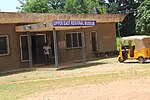 | ||||
| GH-UE-002 | Old Navrongo Catholic Cathedral Building | Upper East | Church | 1920 | Navrongo |  | |||
| GH-UE-003 | Pikworo Slave camp | Upper East | Slave camp | 1704 | Paga |  |
| ID | Description | Region | Original function | Built | Location | Address | Comment | Coordinates | Image |
|---|---|---|---|---|---|---|---|---|---|
| GH-UW-001 | Gwollu Defence Wall | Upper West | Monument | Gwollu | Gwollu is 70 km north of Wa, in the Upper West Region of Ghana |  | |||
| GH-UW-003 | Wa Naa's Palace | Upper West | Palace | Wa |  | ||||
| GH-UW-003 | Wechiau Mosque | Upper West | Mosque | Wechiau |  | ||||
| GH-UW-004 | Dondoli Mosque | Upper West | Mosque | Wa | This 19th Century mosque is in Wa, the capital of the Upper West Region. |  |
The Museum of Archeology, University of Ghana is listed on the QMMB site. [3]

Industrial archaeology (IA) is the systematic study of material evidence associated with the industrial past. This evidence, collectively referred to as industrial heritage, includes buildings, machinery, artifacts, sites, infrastructure, documents and other items associated with the production, manufacture, extraction, transport or construction of a product or range of products. The field of industrial archaeology incorporates a range of disciplines including archaeology, architecture, construction, engineering, historic preservation, museology, technology, urban planning and other specialties, in order to piece together the history of past industrial activities. The scientific interpretation of material evidence is often necessary, as the written record of many industrial techniques is often incomplete or nonexistent. Industrial archaeology includes both the examination of standing structures and sites that must be studied by an excavation.

Champoeg is a former town in the U.S. state of Oregon. Now a ghost town, it was an important settlement in the Willamette Valley in the early 1840s. Located halfway between Oregon City and Salem, it was the site of the first provisional government of the Oregon Country.

The Instituto Nacional de Antropología e Historia is a Mexican federal government bureau established in 1939 to guarantee the research, preservation, protection, and promotion of the prehistoric, archaeological, anthropological, historical, and paleontological heritage of Mexico. Its creation has played a key role in preserving the Mexican cultural heritage. Its current national headquarters are housed in the Palace of the Marqués del Apartado.
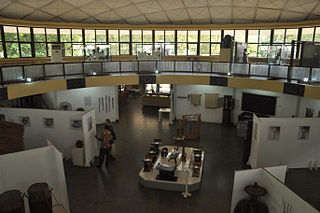
The National Museum of Ghana is in the Ghanaian capital, Accra. It is the largest and oldest of the six museums under the administration of the Ghana Museums and Monuments Board (GMMB).

Cultural heritage is the heritage of tangible and intangible heritage assets of a group or society that is inherited from past generations. Not all heritages of past generations are "heritage"; rather, heritage is a product of selection by society.
Cultural Heritage of Serbia represents the totality of national cultural heritage in Serbia as defined by Serbia's Law on Cultural Goods. Some of national heritage sites in Serbia are also World Heritage Sites.
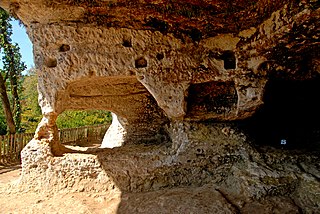
The archaeological site Abri de la Madeleine is a rock shelter under an overhanging cliff situated near Tursac, in the Dordogne département of the Aquitaine Région of South-Western France. It represents the type site of the Magdalenian culture of the Upper Paleolithic. The shelter was also occupied during the Middle Ages. The medieval castle of Petit Marsac stands on the top of the cliff just above the shelter.

Fort Coenraadsburg or Conraadsburg, also Fort São Tiago da Mina, is a small Portuguese chapel built in honor of Saint Jago and it is situated opposite the Elmina Castle in the Central region of Ghana, to protect Fort Elmina from attacks. Owing to its historical importance and testimony to the Atlantic slave trade, Fort Conraadsburg was inscribed on the UNESCO World Heritage List in 1979 along with several other castles in Ghana.

Fort Amsterdam, is a former slave fort in Kormantin, Central region, Ghana. It was built by the English between 1638 and 1645 as Fort Cormantin or Fort Courmantyne, and was captured by admiral Michiel de Ruyter of the Dutch West India Company in 1665, in retaliation for the capture of several Dutch forts by the English Admiral Holmes in 1664. It was subsequently made part of the Dutch Gold Coast, and remained part of it until the fort was traded with the British in 1868. The Fort is located at Abandze, on the north-east of Cape Coast in the Mfantseman District of the Central Region of Ghana. Because of its testimony to European economic and colonial influence in West Africa and its historical importance in the Atlantic slave trade, the fort was inscribed on the UNESCO World Heritage List in 1979 along with other forts and castles in Ghana.

Fort São Sebastião located in Shama, Ghana, is the third oldest fortification in Ghana. Along with several other castles in Ghana, it was inscribed on the UNESCO World Heritage List in 1979 because of its testimony to the history of European trade, colonization, and exploitation in the region.

Fort Orange was built as a trading post on the Dutch Gold Coast in 1642, near Sekondi in the Western Region of Ghana. It functioned as a lodge for a while during the 1670s and that was the original purpose for the fort before it was used as a trading post. The trading post was enlarged into a fort in 1690. It was joined by an English Fort Sekondi in 1682. It was sold with the rest of the Dutch Gold Coast to the United Kingdom in 1872, and now serves as a lighthouse. Because of its historical importance in trade between Europe and Africa, Fort Orange was inscribed on the UNESCO World Heritage List in 1979 along with several other castles and forts in Ghana.

Tuzigoot National Monument preserves a 2- to 3-story pueblo ruin on the summit of a limestone and sandstone ridge just east of Clarkdale, Arizona, 120 feet above the Verde River floodplain. The Tuzigoot Site is an elongated complex of stone masonry rooms that were built along the spine of a natural outcrop in the Verde Valley. The central rooms stand higher than the others and they appear to have served public functions. The pueblo has 110 rooms. The National Park Service currently administers 58 acres, within an authorized boundary of 834 acres.
Protected areas of Ukraine are special areas of Ukraine established with the goal of protecting the natural and cultural heritage of the country from excessive changes as a result of human activity. The protection of the areas is the responsibility of the government of Ukraine, specifically the Cabinet of Ministers of Ukraine.

Fort Apollonia is a fort in Beyin, Ghana. The name Apollonia was given to the area by a Portuguese explorer who sighted the place on the Feast of Saint Apollonia, 9 February. Because of its importance during the European colonial period and its testimony to the Atlantic slave trade, Fort Apollonia was inscribed on the UNESCO World Heritage List along with several other forts and castles in Ghana in 1979.

Fort Komenda was a British fort on the Gold Coast, currently preserved as a ruin. Because of its testimony to the Atlantic slave trade and European economic and colonial influence in West Africa, the fort was inscribed on the UNESCO World Heritage List in 1979, along with several other castles and forts in Ghana.
The Ghana Museums and Monuments Board (GMMB) is the legal organisation responsible for the preservation of Ghana's material cultural heritage. It was founded on 5 March 1957, soon after Ghana became independent, by a merge of the National Museum and the Monuments and Relics Commission by Ordinance 20.

Fort William Lighthouse is located on the Dawson's Hill in the old centre of Cape Coast, in Ghana's Central Region. The lighthouse is often called Cape Coast Castle Light, although it is not part of the Cape Coast Castle complex. It is about 600 metres away from the Castle. Along with the Cape Coast Castle and other castles and forts in Ghana, the lighthouse was inscribed on the UNESCO World Heritage List in 1979 because of its historical importance.

Fort Victoria is a structure in Cape Coast, Ghana. It was initially known as 'Phipps Tower', in honour of its initial constructor English Governor Phipps. Its name was changed later to Fort Victoria in honor of Queen Victoria. Along with other nearby forts and castles, Fort Victoria was inscribed on the UNESCO World Heritage List in 1979 because of its European colonial significance.